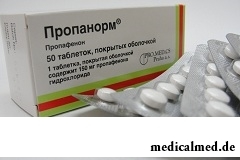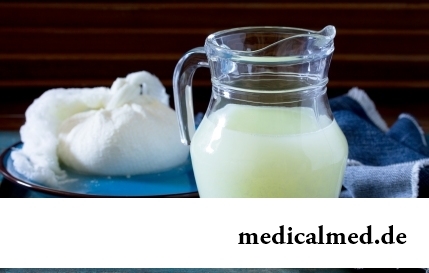





Propanorm
Application instruction:
 Propanorm – antiarrhytmic drug.
Propanorm – antiarrhytmic drug.
Form of release and structure
Dosage forms:
- Tablets, coated: almost white or white color, a round biconvex form (on 10 pieces in the blister, in a cardboard pack of 5 blisters);
- Solution for intravenous (in/in) introductions: colourless transparent liquid (on 10 ml in glass ampoules without color with a break point, in a blister strip packaging of 5 ampoules, in a cardboard pack 2 packagings).
1 tablet contains:
- Active ingredient: a propafenona a hydrochloride – 150 mg or 300 mg that corresponds to the maintenance of a propafenon of 135,7 mg or 271,05 mg;
- Auxiliary components: a gipromelloza 5, starch corn, the microcellulose granulated коповидон, magnesium stearate, sodium of a kroskarmelloz, a macrogoal 6000, sodium lauryl sulfate, an emulsion of a dimetikon from silicon dioxide, titanium dioxide.
1 ml of solution contains:
- Active ingredient: a propafenona a hydrochloride – 3,5 mg;
- Auxiliary components: dextroses (glucose) monohydrate, water for injections.
Indications to use
Tablets, coated
Propanorm's use is shown for prevention and treatment of arhythmic pathologies:
- Paroxysmal disturbances of a rhythm (a WPW-syndrome, supraventricular – fibrillation and an atrial flutter);
- Ventricular and supraventricular premature ventricular contraction;
- Atrioventricular re-entry (mechanism of a repeated return entrance of an impulse) tachycardia.
Besides, tablets are appointed for prevention of steady monomorphic ventricular tachycardia.
Solution for in/in introductions
Solution is appointed for stopping of paroxysms of fibrillation of auricles, by atrial flutters, supraventricular tachycardias, a WPW-syndrome, ventricular tachycardias (in the absence of disturbances of sokratitelny function of a left ventricle).
Contraindications
- The expressed arterial hypotension, the expressed bradycardia;
- Considerable disturbance of water and electrolytic balance (including potassium metabolism);
- Severe form of the chronic obstructive pulmonary disease (COPD);
- Simultaneous use of a ritonavir;
- Sick sinus syndrome;
- Atrioventricular block of the II-III degree;
- The expressed changes of a myocardium of organic genesis: refractory chronic heart failure at fraction of emission of a left ventricle is less than 35%, cardiogenic shock (not including arhythmic shock);
- Breastfeeding period;
- Age up to 18 years;
- Hypersensitivity to drug components.
Besides, use of tablets is contraindicated:
- Disturbance of intra-atrial conduction;
- Distal blockade or blockade of legs of a ventriculonector in the absence of an electrocardiostimulator;
- Myasthenia;
- Uncontrollable chronic heart failure;
- Severe form of chronic heart failure in a decompensation stage.
Additional contraindications to use of solution for in/in injections:
- Acute coronary syndrome;
- Brugad's syndrome;
- gravis myasthenia;
- Disturbance of conductivity of excitement between auricles and ventricles, intra ventricular, sinuatrial blockade at patients without electrocardiostimulator;
- Lengthening of an interval of QT;
- Simultaneous use of tricyclic antidepressants, a tsizaprida, fenotiazin, a bepridil, macroleads for intake (QT of means extending an interval).
With care it is necessary to appoint Propanorm at HOBL of easy and average degree, to patients with the established artificial pacemaker of heart, at advanced age.
Besides:
- Tablets: renal failures and/or liver, gravis myasthenia;
- Solution: bronchial asthma, organic lesions of a myocardium, arterial hypotension, a renal and/or liver failure, hyper - and a hypopotassemia.
Use of tablets and solution during pregnancy is shown only according to vital indications (especially in the I trimester), on condition of exceeding of the expected advantage of therapy for mother over potential threat for a fruit.
Route of administration and dosage
Tablets, coated
Pill is taken inside, after food, swallowing entirely and washing down with enough water.
The doctor appoints the dosing mode and adjusts individually, taking into account clinical indications.
Usual daily dose – 450 mg (on 150 mg 3 times a day every 8 hours). For achievement of desirable therapeutic effect increase in an initial dose each 3-4 days to 600 mg a day (in 2 receptions) or to the maximum daily dose of 900 mg – in 3 receptions can be shown.
The load dose when stopping a paroxysm of fibrillation of auricles makes 600 mg once.
If against the background of Propanorm's use the frequency of emergence and weight of arrhythmia raises, recommended to lower a dose or to temporarily cancel drug.
Patients with body weight is less than 70 have some or 70 years are aged more senior appoint a reduced dose, it is necessary to begin use in the conditions of a hospital under control of the arterial pressure (AP) and an electrocardiography (ECG).
The dosing mode for patients with the broken function of a liver has to make 1/5-1/3 from a usual dose, with an impaired renal function (at clearance of creatinine it is less than 10%) the initial dose is reduced twice.
Solution for intravenous (in/in) introductions
Solution is intended for in/in jet or drop introduction.
For infusion solution it is possible to use only 5% glucose solution!
Long infusion should be carried out in 3-5 minutes after intravenous administration of drug.
The mode of dosing is set by the doctor on the basis of data of an electrocardiography and clinical condition of the patient individually.
The recommended dosing:
- In/in jet introduction: slowly – the drug is administered within 10 minutes from calculation for 1,5-2 mg on 1 kg of weight of the patient. For achievement of clinical effect in 90-120 minutes it is possible to enter this dose repeatedly;
- Short-term infusion: within 60-180 minutes with a speed of 0,5-1 mg of drug a minute – from calculation for 0,5-2 mg on 1 kg of weight. For achievement of clinical effect in 60-120 minutes the procedure can be repeated;
- Long infusions: to 560 mg a day that is equivalent to 160 ml of solution of Propanorm.
The daily dose should not exceed 560 mg.
For treatment of heavy arrhythmia use of short-term and long infusions is shown.
It is necessary to carry out the procedure of administration of drug under careful control of a condition of the patient, in case of considerable change of the heart rate (HR), expansion more than for 25% of the QRS complex or lengthening of an interval of QT more than for 20%, it is necessary to stop infusion immediately!
At an impaired renal function and/or a liver use even of usual therapeutic doses can cause cumulation of a propafenon of a hydrochloride in an organism. At this category of patients use of titratsionny doses of drug under careful control of an ECG and concentration of active agent in a blood plasma is shown.
After cultivation of solution for in/in introductions to 5% glucose solution stability (physical and chemical) drug remains within 72 hours at a temperature of 25 °C. But from the point of view of microbiology it is necessary to prepare solution before direct use. In case of need solution, ready for infusion, can be used within the next few 24 hours provided that temperature of its storage will not exceed 2-8 °C.
Side effects
Tablets, coated
- Cardiovascular system: ventricular tachyarrhythmias, atrioventricular (AV) dissociation, bradycardia, deterioration in course of heart failure (at reduced function of a left ventricle), stenocardia, sinuatrial (SA) blockade, disturbances of intra ventricular conductivity, AV blockade, supraventricular tachyarrhythmias, against the background of high doses – orthostatic hypotension;
- Nervous system: dizziness, headache; seldom – a diplopia, spasms, a sight illegibility;
- Alimentary system: dryness in a mouth, change of flavoring feelings, bitterness in a mouth, a loss of appetite, nausea, weight in an epigastric zone, a lock, diarrhea; seldom – functional disorder of a liver, a cholestasia, cholestatic jaundice;
- Urinogenital system: decrease in a potentiality, oligospermatism;
- Allergic reactions: skin itch, rash, erubescence, dieback, volchanochnopodobny syndrome, small tortoiseshell;
- Laboratory indicators: emergence of antinuclear antibodies, agranulocytosis, leukopenia, increase in duration of bleeding, thrombocytopenia;
- Others: bronchospasm, weakness, enanthesis of hemorrhagic character.
Solution for in/in introductions
- Cardiovascular system: very often – a heart consciousness, conductivity disturbances; often – bradycardia, at reduced sokratitelny function of a left ventricle – weighting of a course of heart failure; SA blockade, AV blockade, ventricular tachyarrhythmias, disturbances of intra ventricular conductivity, supraventricular tachyarrhythmias, at reception in high doses – a considerable lowering of arterial pressure (including postural and orthostatic hypotension); seldom – pro-arrhythmias (increase of pulse (tachycardia), fibrillations of ventricles); frequency is unknown – deterioration in a course of chronic heart failure;
- Nervous system: very often – dizziness; often – a syncope; infrequently – confusion of consciousness, alarm, a headache, paresthesia, an ataxy; seldom – an illegibility of visual perception, a diplopia; frequency is unknown – extrapyramidal symptoms, spasms;
- Alimentary system: often – a xerostomia, dispeptic frustration, taste disturbance; infrequently – a cholestasia, liver diseases, hepatitis, jaundice; frequency is unknown – an emetic desire;
- Mammary glands and generative organs: seldom – impotence; frequency is unknown – passing decrease in quantity of spermatozoa;
- Connecting fabrics and musculoskeletal system: seldom – a syndrome with symptoms of a system lupus erythematosus;
- Laboratory researches: infrequently – thrombocytopenia, increase in activity of enzymes of a liver (an alkaline phosphatase, alaninaminotranspherase, an asparaginaminotransferaza); seldom – an agranulocytosis, a leukopenia; frequency is unknown – a granulocytopenia;
- Allergic reactions: infrequently – rash, an itch, erubescence, a small tortoiseshell;
- Others: bronchospasm, weakness, arthralgia.
Special instructions
The entire period of therapy should be accompanied with regular carrying out an ECG, control of activity of hepatic transaminases, electrolytic balance (especially potassium concentration level in blood).
In the presence of disturbances of electrolytic balance they should be corrected prior to drug use.
Because of the increased risk of aritmogenny activity of a propafenon it is necessary to begin treatment in the conditions of a hospital.
Propanorm's use for treatment of ventricular disturbances of a rhythm has more effective effect, than the antiarrhytmic drugs IA and IB of a class.
Bioavailability of drug at patients with a liver failure is 70% higher usual therefore they should appoint a reduced dose and to regularly control laboratory parameters.
At patients with an artificial pacemaker of heart it is necessary to approach with extra care definition of indications and doses of drug.
At prolonged use of anticoagulants and hypoglycemic means the patient needs regular clinical observation and careful control of laboratory indicators.
Against the background of use of solution on an ECG emergence of brugadopodobny changes and diagnosing of an asymptomatic current of a syndrome of Brugad is possible. Therefore administration of drug should be accompanied with electrocardiological inspection.
In case of manifestation against the background of reception of a propafenon of AV of blockade of the III degree, SA of blockade or often repeating premature ventricular contraction therapy should be cancelled.
Because of risk of proaritmogenny influence use of drug is shown only to destination and under observation of the doctor.
Propanorm exerts impact on ability to concentrate attention, speed of psychomotor reactions therefore during treatment the patient should refrain from control of vehicles and mechanisms.
Medicinal interaction
At simultaneous use of Propanorm:
- Lidocaine strengthens cardiodepressive effect of drug therefore this combination is contraindicated;
- Propranolol, indirect anticoagulants, метопролол, cyclosporine increase the concentration in a blood plasma;
- Digoxin increases risk of development of glikozidny intoxication;
- Warfarin strengthens the action against the background of metabolism blocking;
- Local anesthetics increase risk of damage of the central nervous system;
- Tricyclic antidepressants, beta adrenoblockers can strengthen antiarrhytmic effect of drug;
- Amiodaronum increases probability of emergence of tachycardia like "pirouette";
- Quinidine, Cimetidinum promote increase in concentration of a propafenon in a blood plasma for 20%;
- Rifampicin, accelerating metabolism, reduces therapeutic effect of drug (dose adjustment is required).
At the accompanying therapy by the means oppressing a marrowy hemopoiesis the risk of a miyelosupressiya increases.
The probability of development of side effects of Propanorm increases at a combination to the drugs possessing negative inotropic effect or oppressing AV and SA nodes.
Terms and storage conditions
To protect from children.
To store in the place protected from light and moisture at a temperature of 15-25 °C.
Period of validity: tablets – 3 years, solution – 4 years.
Name of drug
Price
Drugstore
Propanorm тбл п/пл/о 150 mg No. 50, Pro.Med.CS Praha
334 rub.
 Network of the Moscow drugstores of IFC
Network of the Moscow drugstores of IFCPropanorm тбл 300 mg No. 50, Pro.Med.CS Praha
542 rub.
 Network of the Moscow drugstores of IFC
Network of the Moscow drugstores of IFCPeople who got used to have breakfast regularly have obesity much less often.

Milk and products of its processing by right occupy one of the main places in a diet of the modern person. They contain necessary...
Section: Articles about health
Each person has easy indispositions which he transfers "standing", trying not to ask for medical care. Arguments at the same time are adduced same: "it is a trifle, itself will pass", "I have too many important issues", "there are no wish to spend time on...
Section: Articles about health
Heart disease and blood vessels lead to disturbance of blood supply of bodies and fabrics that involves failures in their work, deterioration in health of the person, decrease in its working capacity and standard of living. Annually more than 17 million inhabitants of our planet perish from pathologies such....
Section: Articles about health
Musicotherapy – a treatment method which caused and causes a set of a controversy concerning its efficiency. However the facts are relentless:...
Section: Articles about health
It is impossible to imagine human life in which there would be no plants. Practically in each apartment and any production room there are window plants, millions of people with pleasure are engaged in gardening and truck farming, many citizens пр...
Section: Articles about health
Zone hypostases under eyes - very widespread problem giving to people is a lot of inconvenience. Hypodermic fabric in these parts has very loose structure and almost does not contain collagenic fibers. Besides, the skin covering подглазья constantly is exposed to compression and stretching when the person blinks, blinks, etc. These features also create premises for emergence of the so-called bags which are giving to the face a tired and sickly look, and also visually adding increased...
Section: Articles about health
Mushrooms - the surprising inhabitants of our planet having a set of wonderful qualities. Thanks to one of them, a mold mushroom of Penici...
Section: Articles about health
Bees – really unique beings. Practically all products of their life activity are used by the person. Since the most ancient times medicinal properties of honey and other substances received in the course of beekeeping are known. The fact that all these пр is especially significant...
Section: Articles about health
It would seem, about it there can be no disagreements: water is necessary for a human body for normal life activity, and about how and when it should be drunk, all know. It turned out that the situation is not absolutely so: for many years there are very persistent delusions connected with this question. Let's consider the most widespread of them....
Section: Articles about health
Impossibility to conceive the child – a trouble of many Russian families. During quite long time was considered that the main "culprits...
Section: Articles about health
The mankind knows that some toxins at intake in the minimum quantities have therapeutic effect from an extreme antiquity. Many substances recognized poisonous are applied in the medical purposes also today, being the main deystvuyushch...
Section: Articles about health
Aspirin (acetylsalicylic acid) – one of those drugs which are known literally to all. It is available in each home first-aid kit, and many accept it at the first signs of an indisposition, often without having a fair idea of properties and therapeutic effect of drug. Meanwhile, impact of aspirin on a human body is very various, and is not always favorable. About it it is important to foreknow, in order to avoid emergence of problems with health....
Section: Articles about health
The sudden heat on all body which is followed by perspiration and a cardiopalmus – the phenomenon familiar to many people. Most often such states called by "inflows" result from nervous or physical overworks and disappear right after rest. However in certain cases similar reaction of an organism can speak about diseases which need treatment. What? About it below....
Section: Articles about health
Striya (extension) are the defects of skin having an appearance of direct or wavy strips from 1 to 10 cm long and 1-5 mm wide. In the majority with...
Section: Articles about health
Each failure in work of bodies and systems of a human body is, as a rule, shown by the whole complex of symptoms. In particular, malfunctions with health often cause emergence of cosmetic defects in the form of rashes on a face. Experienced doctors know that локализац...
Section: Articles about health
High temperature - a frequent symptom of such widespread diseases as a SARS, quinsy, pneumonia, etc. To reduce heat, having facilitated a condition of the patient, doctors recommend to accept antipyretics, however their use is not always possible. Too frequent use of these drugs can lead to allergic reactions, and also overdose, causing poisoning. It happens also that there are no antipyretics simply in the house. In these situations it is pertinent to use it...
Section: Articles about health
The unpleasant feelings connected with spring breakdown are familiar almost to each of us. Often happens that in March-April on the person...
Section: Articles about health
We live during an advertizing era. Daily each person receives a solid portion of persuasive councils about what to eat to be healthy and successful. Products about which we will talk today are combined by the following circumstance: all of them are positioned as most...
Section: Articles about health
Venereal diseases in medicine are called the infections which are transmitted preferential sexually, now they and are called - infections, sexually transmitted, or STD. Among them is also life-threatening. In spite of the fact that the majority of diseases such will respond to treatment, they are widespread everywhere, and there is no tendency to decrease in incidence. Besides, some of them promptly look younger: statistically, a third of young people at the age of 16-22 years of a str...
Section: Articles about health
The problem of diagnosis was and remains to one of the most important in medicine. From that, the reason недо will be how precisely defined...
Section: Articles about health
The technique of acupuncture (acupuncture) is used in the medical purposes more than three and a half millennia. It is eurysynusic and recognized as official medicine in the majority of the developed countries of the world. Influence by fine needles on so-called points...
Section: Articles about health
Contrary to popular belief, the multiple sclerosis (MS) is not connected neither with sclerous changes of walls of vessels, nor with age forgetfulness and problems with concentration of attention. This disease has the autoimmune nature. Pathological process is expressed in degradation of nervous tissue and destruction of its enveloping layer - a myelin. Multiple damages of the central nervous system which are shown by decrease in sight, bystry fatigue, on become result of development of an illness...
Section: Articles about health
An eye of the person daily experiences considerable strain. The problem of preservation of sight is for many years directly connected with a question снабж...
Section: Articles about health
Climax - process of fading of reproductive function of an organism in process of its aging. At women the main sign of its approach is the termination of a menstrual cycle. Officially the menopause is diagnosed when periods are not observed in течен...
Section: Articles about health
The kid who was recently born is surrounded with love of adult family members and their cares without which the baby cannot exist. Some parents consider that gentle attachment and caress are quite enough that the child correctly developed and was happy, but it not so. It is important to know as much as possible about specifics of care of the baby, the reasons of his behavior and possible problems. Only the "able to see" love will provide to the little man that it is necessary for him....
Section: Articles about health



